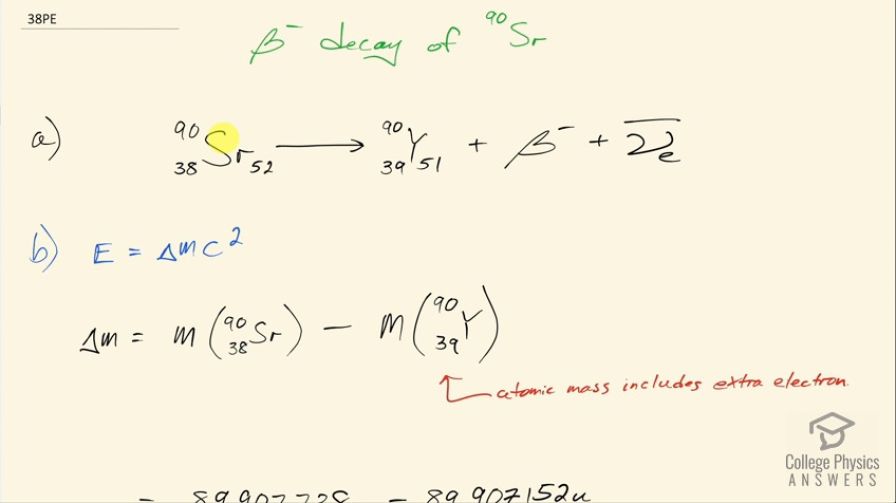Question
(a) Write the complete decay equation for , a major waste product of nuclear reactors. (b) Find the energy released in the decay.
Final Answer
- Please see the solution video.
Solution video
OpenStax College Physics for AP® Courses, Chapter 31, Problem 38 (Problems & Exercises)

vote with a rating of
votes with an average rating of
.
Calculator Screenshots
Video Transcript
This is College Physics Answers with Shaun Dychko. This question asks us to write the β-decay equation for strontium-90. So we start with strontium-90 on the left side and we put a β particle on the right side and then a compensating electron anti-neutrino to compensate for the positive electron family number in the β particle, we need a compensating negative electron family number from this electron-neutrino anti-particle. So we have to look up how many protons are in strontium so we look at this appendix at the end of the textbook and we see that for strontium-90, there are 38 protons and we know that in β decay, a neutron turns into a proton and an electron. So we expect to have one fewer neutron here so the number of neutrons decrease by 1 and then there's a compensating increase in the number of protons; the total number of nucleons stays the same— there's 90 in both cases— it's just that one of the neutrons has turned into a proton and in order for a charge to be conserved, an extra positive charge is created in this process we need to have a compensating negative charge to offset the additional positive so that total charge on the left and right is zero in both cases. Okay! So there's the β decay equation for strontium-90. In part (b) we are asked to figure out how much energy is released in this decay? So that's going to equal the difference in mass between the nuclide on the left and all of the products on the right multiplied by c squared. Now there's one little confusing detail in this calculation here in that we are dealing with atomic masses in this data table here. So the atomic mass includes the mass of the surrounding electrons that surround the nucleus and yttrium has 39 protons and therefore 39 electrons in its atomic mass here and when we calculate this difference here, we are interested just in the difference in the mass of the nuclide which is this thing minus the electrons and this nuclide plus this single electron that's here. Now what's convenient though is it because this atomic mass has an extra electron versus the strontium atomic mass because the strontium atomic mass includes 38 electrons whereas the yttrium atomic mass includes 39 electrons, this difference will be the difference in mass of the nuclides plus an extra electron included here which is what we want since this electron is being produced in this decay. So hopefully that makes sense. So we have 89.907738 atomic mass units for strontium-38 minus this which I looked up for yttrium-39 and that works out to 5.86 times 10 to the minus 4 atomic mass units which we then multiply by 931.5 megaelectron volts per c squared for every atomic mass unit and then we multiply by c squared and the energy released is 0.546 megaelectron volts.
